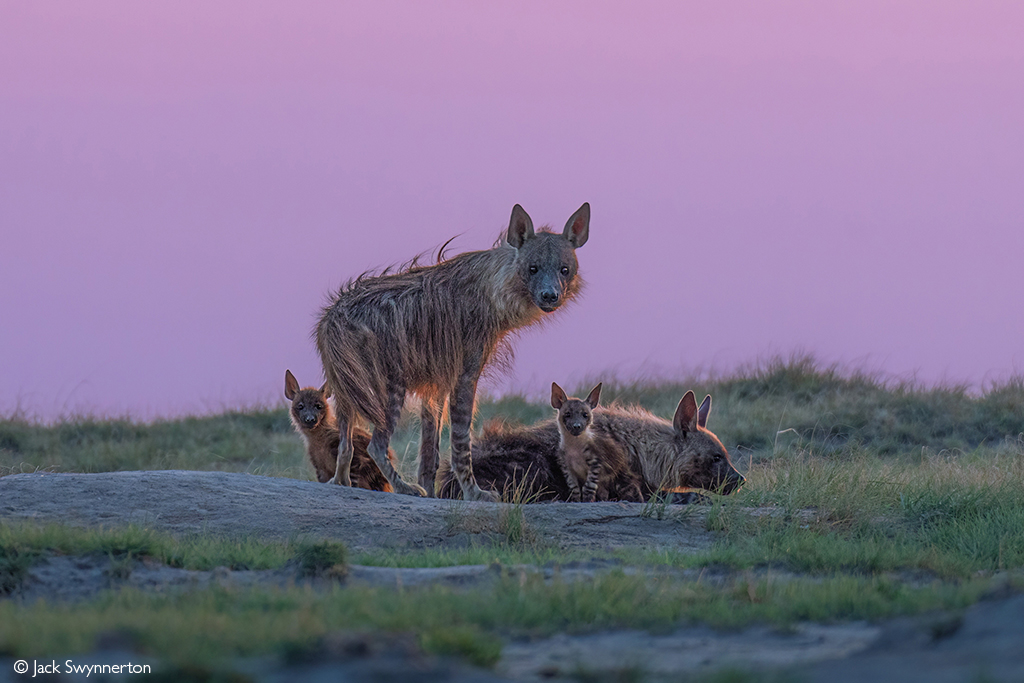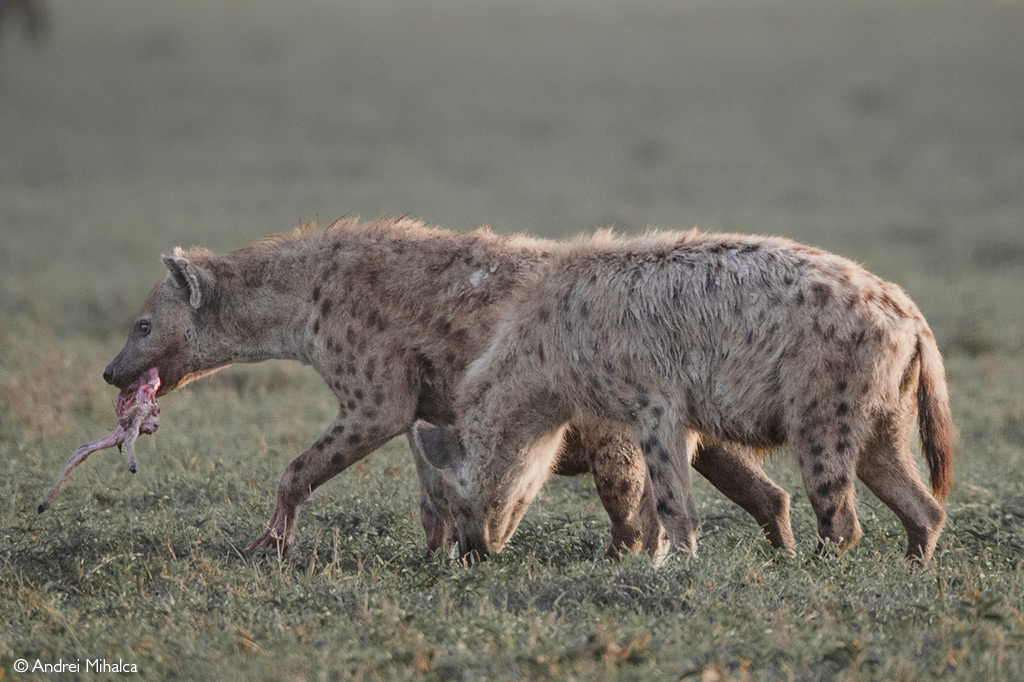
There are four extant species of the family Hyaenidae: aardwolf (Proteles cristata), brown hyena (Parahyaena brunnea), spotted hyena (Crocuta crocuta) and striped hyena (Hyaena hyaena). A recent review of scientific literature on Hyeanidae (analysing 907 papers) reveals the trends and gaps in the research on hyenas and other Hyaenidae species.
My first memory of a hyena comes from when I was six years old. My family lived in a research camp in the Okavango Delta, while my father was studying baboons. I woke up one night to the clamour of hyenas cackling and my mother shouting. Four spotted hyenas had barged through the reed door of the hut to see if they could get their jaws on my father’s uneaten supper (he was out watching baboons that night). My mom yelled at them and banged pots with a big spoon, putting them off their mission, so my first human-hyena conflict ended on a good note. We rescued most of the supper, and the hyenas fled from my spoon-wielding mother. However, hyenas generally get a bad rap, even though not all human-hyena interactions are negative.
When researchers recently set out to review scientific literature on Hyeanidae, they found a number of gaps in the research around various species, including in studies on the outcomes of human-Hyaenidae interactions.


Hyena in the eyes of the public
It is worth remembering that Hyaenidae species are important to ecosystems and are a big drawcard for tourists embarking on an African safari. They are also biodiversity indicators, but there are also negative connotations associated with hyenas. The three bone-cracking Hyaenidae species (brown, spotted and striped hyena) may prey on threatened species; and they sometimes prey on livestock. Hyenas have occasionally been known to attack humans or scavenge human remains. They are also somewhat difficult to study, being nocturnal, wide-ranging and long-lived. But Hyaenidae contribute to the ecosystem in numerous ways, including through disease regulation. The literature review highlights an imbalance in reporting on the positive effects of hyenas. A quarter of all literature on Hyaenidae is focused on human-hyena interactions, and the majority of this reports on conflicts and livestock predation events. In contrast, very few of these studies reported on the human impacts on Hyaenidae, such as infrastructure impacts or snare and poisoning events.
 Want to plan your African safari to spot Hyaenidae in the wild? We have ready-made safaris to choose from, or start planning a unique safari made just for you.
Want to plan your African safari to spot Hyaenidae in the wild? We have ready-made safaris to choose from, or start planning a unique safari made just for you.
The studies conducted on Hyaenidae since 1900 have not been balanced concerning species, place or topic. For example, there were only 44 field studies on aardwolves and 519 on spotted hyenas. Only 66% of the 67 Hyaenidae-range states have produced at least one hyena publication, and most of the studies have been done in South Africa, Kenya and Tanzania. Topics have changed from focusing on basic biology to distribution and range, human–hyena interactions and anthropogenic impacts. Most of the studies (60%) were within (or at least partially conducted within) a protected area. Yet only 2.6%, 0.2%, 3.4% and 1.2% of the ranges for aardwolves, brown hyenas, spotted hyenas and striped hyenas, respectively, are comprised of protected areas!


The primary threats to Hyaenidae are habitat loss and fragmentation, declining prey populations and conflict with humans. The first two exacerbate the third, as with increased habitat loss and prey reductions, Hyaenidae are forced into closer contact with humans, and conflicts increase. Given the increasing pressures on hyenas and wild areas under burgeoning human populations and climate change impacts, we must shift our research focus to human-Hyaenidae interactions and conflict management. There were no studies, for example, on aardwolf disease transmission, human infrastructure navigation, immigration, and dispersal. Yet the impact of roads and human development on Hyaenidae is pervasive.

It is food for thought: how do academics decide to prioritise research? Are research topics ad hoc or based on the most apparent species? The spotted hyena has the lion’s share of the publications, and one might consider this to be because it is the ‘extrovert’ of the hyenas, adaptable, opportunistic, and an apex predator that comes into conflict with humans more so than the brown and striped hyena, which also consume livestock. (The termite-snacking aardwolf sometimes comes under fire from humans, too, because of mistaken identity.) We need to consider whether scientific research is being conducted opportunistically. From the results of this study, it appears that horizon scanning is an essential element for prioritising research topics – what are the present and future threats, and what do we need to know to mitigate these?
The authors suggest that significant conservation concerns are being overlooked, such as whether the “Least concern” IUCN classification of the aardwolf is accurate given the scarcity of data on distribution and population. We don’t even know whether the genetically differentiated north-eastern aardwolf population might, in fact, be a different species from the southern population.
For the common good
The authors recommend that going forward, research should be directed towards understanding what it takes for Hyaenidae to “survive, thrive and co-exist with humans”. They emphasise the importance of community engagement in effective management and conservation, which few Hyaenidae studies have incorporated. Valuing meaningful community engagement in wildlife research is critical for anticipating and mitigating the challenges of human-wildlife interactions.
Even though the hyenas are considered “common”, this “common-ness” should be maintained, given that Hyaenidae have a unique ecological role and are indicators of the bigger picture of the biodiversity of our socio-ecological landscapes.
References
Wilkinson, C.E., Dheer, A., Zett, T., Torrents-Ticó, M., Yarnell, R.W., Bar Ziv, E., Bhandari, S., Jacobson, A. and Dloniak, S.M. (2023), Review of the global research on Hyaenidae and implications for conservation and management. Mammal Review.
Resources
Read more about spotted hyenas here, brown hyenas here and striped hyenas here.
Read all there is to know about the aardwolf here.
To comment on this story: Login (or sign up) to our app here - it's a troll-free safe place 🙂.![]()





